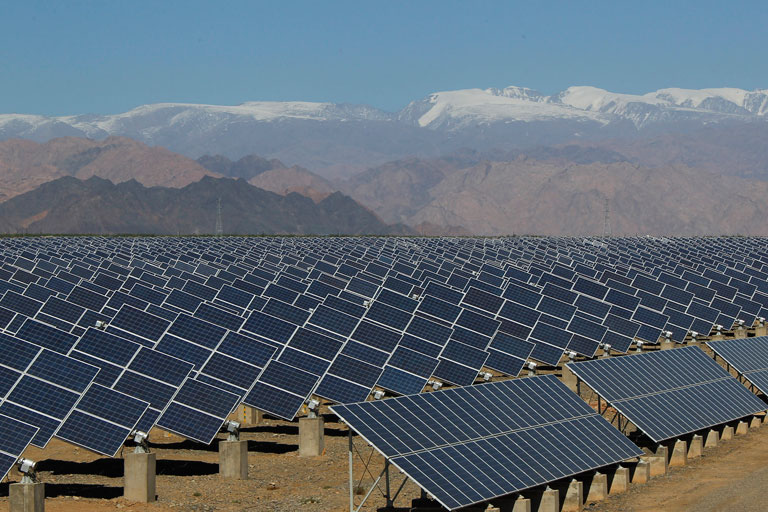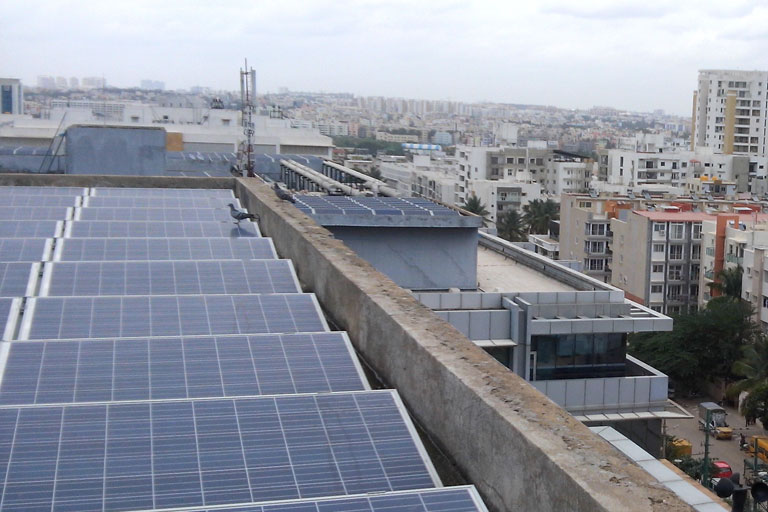Unprecedented investments in solar power in the rapidly developing economies of China and India promise a renewable energy revolution with steel at its heart
The International Energy Agency (IEA) predicts that solar power could be the world’s largest source of electricity by 2050, and a major renewables push by the two countries likely to be this century’s economic powerhouses suggests this isn’t unrealistic.
Earlier this year, China exceeded its already ambitious plan to install 105 gigawatts (GW) of solar capacity by 2020 as part of its 13th Five Year Plan, forcing administrators to revise the target to 213GW. Close on its heels, India aims to install 100GW by 2022 as part of its National Solar Mission. The fact that a typical coal power plant generates half a gigawatt gives some sense of the scale of their ambitions.
Of the five largest solar power plants in the world, three are Chinese and two are Indian
China already leads the world in terms of installed solar capacity, topping 112GW in July. At the end of last year, India was seventh in the IEA’s rankings with 9GW, but it added the fourth most capacity in 2016 and hit 16.2GW by September this year, hinting at its rapidly increasing commitment to solar.
A look at the rankings for the world’s largest solar installations highlights where the real ambition is – of the five largest solar power plants in the world, three are Chinese and two are Indian. And neither country is stopping there; India has plans for an extraordinary 10GW solar park in the northern state of Rajasthan, while China wants to build 100 panda-shaped solar installations along its planned Silk Road Economic Belt trade corridor.
 A solar farm in the Xinjiang Uygur Autonomous Region of China
A solar farm in the Xinjiang Uygur Autonomous Region of China
This enormous expansion will obviously require huge amounts of raw materials and steel will be at the centre of it all. It is an obvious choice for the structural components that support solar panels thanks to its combination of strength, corrosion resistance and affordability. Solar farms are often in remote areas and subject to highly variable environmental conditions, such as snow, humidity or high wind, so excellent durability is essential to keeping down maintenance costs.
At the same time, remote solar installations covering vast areas require lots of new electricity transmission infrastructure. Overhead power lines normally feature steel cores to provide the strength necessary for them to span large distances between transmission towers, also typically made using a steel lattice. Additionally, Steel is an essential ingredient in transformers, whose cores consist of special steel tailored to have specific magnetic properties.
The drive for solar power is not only restricted to large, remote solar installations though. India’s targets assume 40GW will come from solar panels installed on top of buildings, while in China, Bloomberg New Energy Finance predicts that rooftop solar will account for as much as 40GW by 2020 and as much as 125GW by 2040 by. Here again, steel makes an excellent material for the structural mountings and fasteners required, and architects may also be tempted to choose steel roofing solutions specifically developed to be compatible with solar panels.
 Rooftop solar panels in Bangalore, India
Rooftop solar panels in Bangalore, India
While the bulk of the growth in solar power is in photovoltaic panels that directly convert light to electricity, other methods use the heat of the sun to generate energy. Fields of mirrors mounted on steel frames that move to follow the sun throughout the day concentrate sunlight to heat a fluid that can then be used to drive a turbine. A particularly promising approach heats molten salts to more than 1,000°C before using them to generate steam.
These salts hold their temperature very efficiently, allowing energy from the sun to be stored for later use, a major advantage compared with other intermittent renewable sources. However, they are both hot and highly corrosive, so storage tanks have to be made out of specially designed resistant stainless steel. US firm SolarReserve has signed a deal with coal provider Shenhua Group to install a gigawatt of this kind of solar power in China.
Solar farms are often in remote areas and subject to highly variable environmental conditions so excellent durability is essential to keeping down maintenance costs.
On a smaller scale, the sun is also used to heat water for domestic use by circulating it through a series of tubes inside a panel called a solar collector, which traps the sun’s heat. Stainless steel is a popular choice for both the frame of the collector and the tanks used to store water, again thanks to its durability.
In colder climates, where there is a danger of frost, solar heaters often heat non-freezing fluid in the collector before pumping it to a heat exchanger, which features a circuit of ultra-thin metal tubes designed to transfer heat to a tank of water. To ensure efficient heat transfer the walls of these tubes have to be very thin while still able to resist high pressures, which makes steel a popular material choice thanks to its excellent mechanical properties.
While these various strategies for harnessing the sun’s energy are likely to gain traction at different rates in China and India, the desire to meet their ambitious targets and broader commitments in the Paris climate agreement suggests solar has a bright future in these evolving economies.
Images: Getty